Mechanical Properties of Fire-Damaged RC Beams Reinforced with Carbon Fiber Mesh
Abstract
:1. Introduction
2. Test Overview
2.1. Raw Material
2.2. Sample Design and Production
2.3. Heating Test
2.4. Beam Reinforcement
2.4.1. Construction Process for Reinforcing RC Beams with One-Layer CFM
2.4.2. Construction Process of Three-Layer CFM
2.5. Loading Devices and Systems
3. Experimental Results and Analysis
3.1. Internal Temperature of the Specimen
3.2. Phenomenon during the Loading Process
3.3. Failure Modes Analysis of RC Beams
3.4. The Impact of Temperature on the Load–Displacement Curve of Beams
3.5. Influence of CFM Layers on the Load–Displacement Curve of RC Beams
4. Analysis of the Mechanical Properties of RC Beams
5. Conclusions
Author Contributions
Funding
Data Availability Statement
Conflicts of Interest
References
- Cui, Y.Q.; Peng, Y.L.; Luo, C.L. Study on the fire protection technologies for external thermal insulation system of the buildings. Appl. Mech. Mater. 2014, 638–640, 1646–1649. [Google Scholar] [CrossRef]
- Song, R.L. Research on Ultimate bearing capacity of reinforced concrete columns subjected to fire. Adv. Mater. Res. 2014, 1055, 171–174. [Google Scholar] [CrossRef]
- Choi, E.G.; Shin, Y.S. The structural behavior and simplified thermal analysis of normal-strength and high-strength concrete beams under fire. Eng. Struct. 2011, 33, 1123–1132. [Google Scholar] [CrossRef]
- Ryu, E.; Shin, Y.; Kim, H. Effect of loading and beam sizes on the structural behaviors of reinforced concrete beams under and after fire. Int. J. Concr. Struct. Mater. 2018, 12, 54. [Google Scholar] [CrossRef]
- Banerji, S.; Kodur, V.; Solhmirzaei, R. Experimental behavior of ultra high performance fiber reinforced concrete beams under fire conditions. Eng. Struct. 2020, 208, 110316. [Google Scholar] [CrossRef]
- Van Cao, V. Reliability-based moment capacity assessment of reinforced concrete beams in fire. Int. J. Civ. Eng. 2022, 20, 1291–1308. [Google Scholar] [CrossRef]
- Kodur, V.K.R.; Banerji, S. Comparative fire behavior of reinforced concrete beams made of different concrete strengths. Fire Technol. 2023. [Google Scholar] [CrossRef]
- Yin, S.; Yu, Y.; Xi, Y. Flexural performance of TRC-strengthened RC beam under chloride environment. Anti-Corros. Methods Mater. 2018, 65, 444–450. [Google Scholar] [CrossRef]
- Nahum, L.; Peled, A.; Gal, E. The flexural performance of structural concrete beams reinforced with carbon textile fabrics. Compos. Struct. 2020, 239, 111917. [Google Scholar] [CrossRef]
- Sheng, J.; Yu, Z.; Dou, G.; Liu, H. Fatigue damage behaviors of TRC-strengthened RC beams. Materials 2022, 15, 5113. [Google Scholar] [CrossRef]
- Karalar, M. Experimental and numerical investigation on flexural and crack failure of reinforced concrete beams with bottom ash and fly ash. Iran. J. Sci. Technol. Trans. Civ. Eng. 2020, 44, 331–354. [Google Scholar] [CrossRef]
- Özkılıç, Y.O.; Başaran, B.; Aksoylu, C.; Karalar, M.; Martins, C.H. Mechanical behavior in terms of shear and bending performance of reinforced concrete beam using waste fire clay as replacement of aggregate. Case Stud. Constr. Mater. 2023, 18, e02104. [Google Scholar] [CrossRef]
- Başaran, B.; Aksoylu, C.; Özkılıç, Y.O.; Karalar, M.; Hakamy, A. Shear behaviour of reinforced concrete beams utilizing waste marble powder. Structures 2023, 54, 1090–1100. [Google Scholar] [CrossRef]
- Özkılıç, Y.O.; Karalar, M.; Aksoylu, C.; Beskopylny, A.N.; Stel’makh, S.A.; Shcherban, E.M.; Qaidi, S.; Pereira, I.D.S.A.; Monteiro, S.N.; Azevedo, A.R.G. Shear performance of reinforced expansive concrete beams utilizing aluminium waste. J. Mater. Res. Technol. 2023, 24, 5433–5448. [Google Scholar] [CrossRef]
- Ahmed, A.; Kodur, V. The experimental behavior of FRP-strengthened RC beams subjected to design fire exposure. Eng. Struct. 2011, 33, 2201–2211. [Google Scholar] [CrossRef]
- Turkowski, P.; Łukomski, M.; Sulik, P.; Roszkowski, P. Fire resistance of CFRP-strengthened reinforced concrete beams under various load levels. Procedia Eng. 2017, 172, 1176–1183. [Google Scholar] [CrossRef]
- Kodur, V.K.R.; Yu, B. Rational Approach for evaluating fire resistance of FRP-strengthened concrete beams. J. Compos. Constr. 2016, 20, 04016041. [Google Scholar] [CrossRef]
- Douk, N.; Vu, X.H.; Larbi, A.S.; Audebert, M.; Chatelin, R. Numerical study of thermo mechanical behaviour of reinforced concrete beams with and without textile reinforced concrete (TRC) strengthening: Effects of TRC thickness and thermal loading rate. Eng. Struct. 2021, 231, 111737. [Google Scholar] [CrossRef]
- Protchenko, K. Residual fire resistance testing of basalt- and hybrid-FRP reinforced concrete beams. Materials 2022, 15, 1509. [Google Scholar] [CrossRef]
- Haddad, R.H.; Almomani, O.A. Recovering flexural performance of thermally damaged concrete beams using NSM CFRP strips. Constr. Build. Mater. 2017, 154, 632–643. [Google Scholar] [CrossRef]
- Abdulrahman, A.S.; Kadir, M.R.A. Behavior and flexural strength of fire-damaged high-strength reinforced rectangular concrete beams with tension or compression zones exposed to fire repaired with CFRP sheets. Case Stud. Constr. Mater. 2021, 15, e00779. [Google Scholar] [CrossRef]
- Abdulrahman, A.S.; Kadir, M.R.A. Behavior and flexural strength of fire damaged high strength reinforced rectangular concrete beams after strengthening with CFRP laminates. Ain Shams Eng. J. 2022, 13, 101767. [Google Scholar] [CrossRef]
- GB 50010-2015; Code for Design of Concrete Structures, Ministry of Housing and Urban Rural Development of the People’s Republic of China Code. General Administration of Quality Supervision, Inspection and Quarantine of the People’s Republic of China: Beijing, China, 2014. (In Chinese)
- GB 5508-2021; General Code for Concrete Structures, Ministry of Housing and Urban Rural Development of the People’s Republic of China Code. General Administration of Quality Supervision, Inspection and Quarantine of the People’s Republic of China: Beijing, China, 2014. (In Chinese)
- 13G311-1; Reinforced Concrete Structure. China Institute of Building Standard Design & Research: Beijing, China, 2013. (In Chinese)
- GB 50367-2013; Code for Design of Strengthening Concrete Structure, Ministry of Housing and Urban Rural Development of the People’s Republic of China Code. General Administration of Quality Supervision, Inspection and Quarantine of the People’s Republic of China: Beijing, China, 2014. (In Chinese)
- CECS 146:2003; Technical Specification for Strengthening Concrete Structures with Carbon Fiber Reinforced Polymer Laminate. China Association for Engineering Construction Standardization: Beijing, China, 2003. (In Chinese)
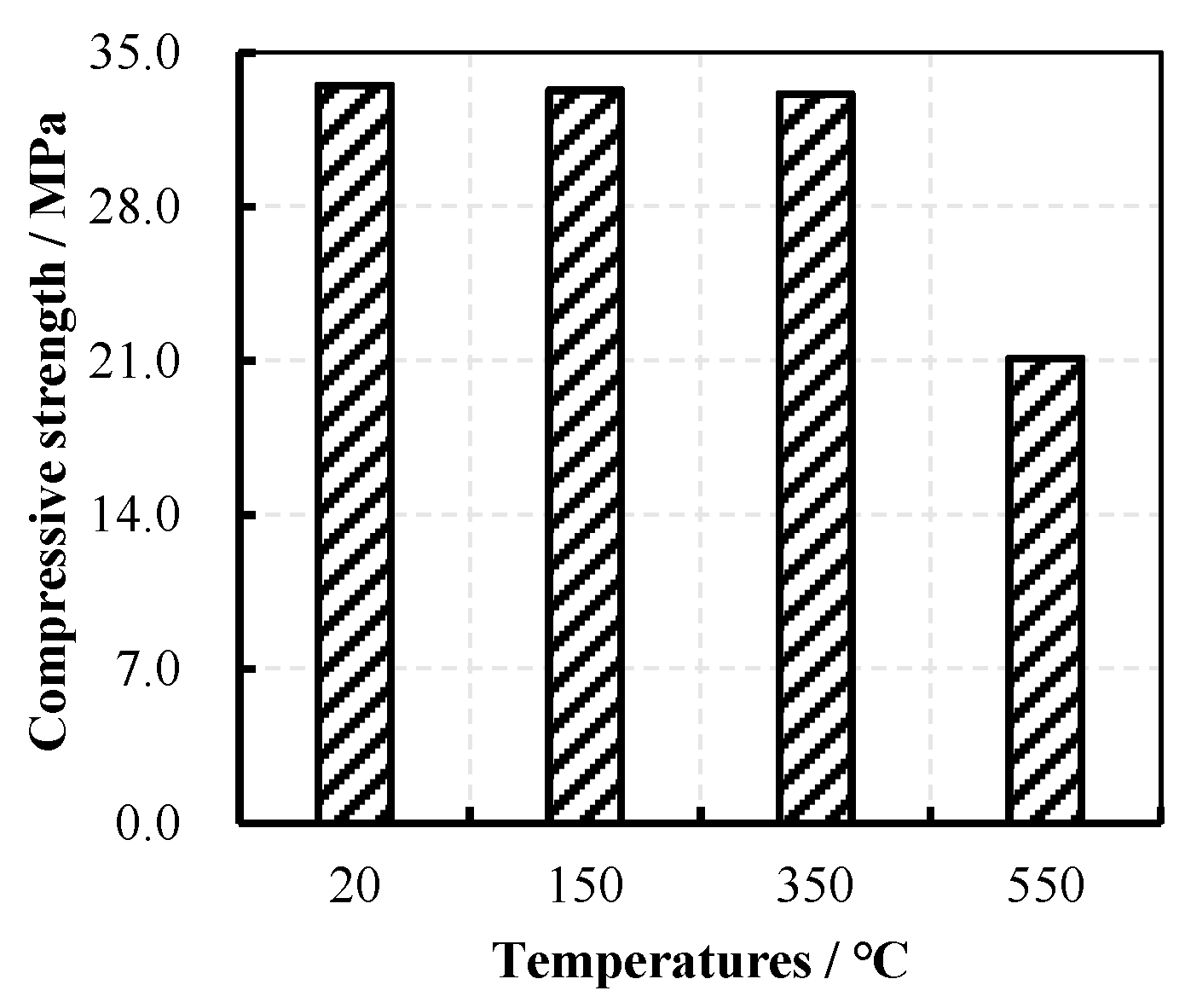




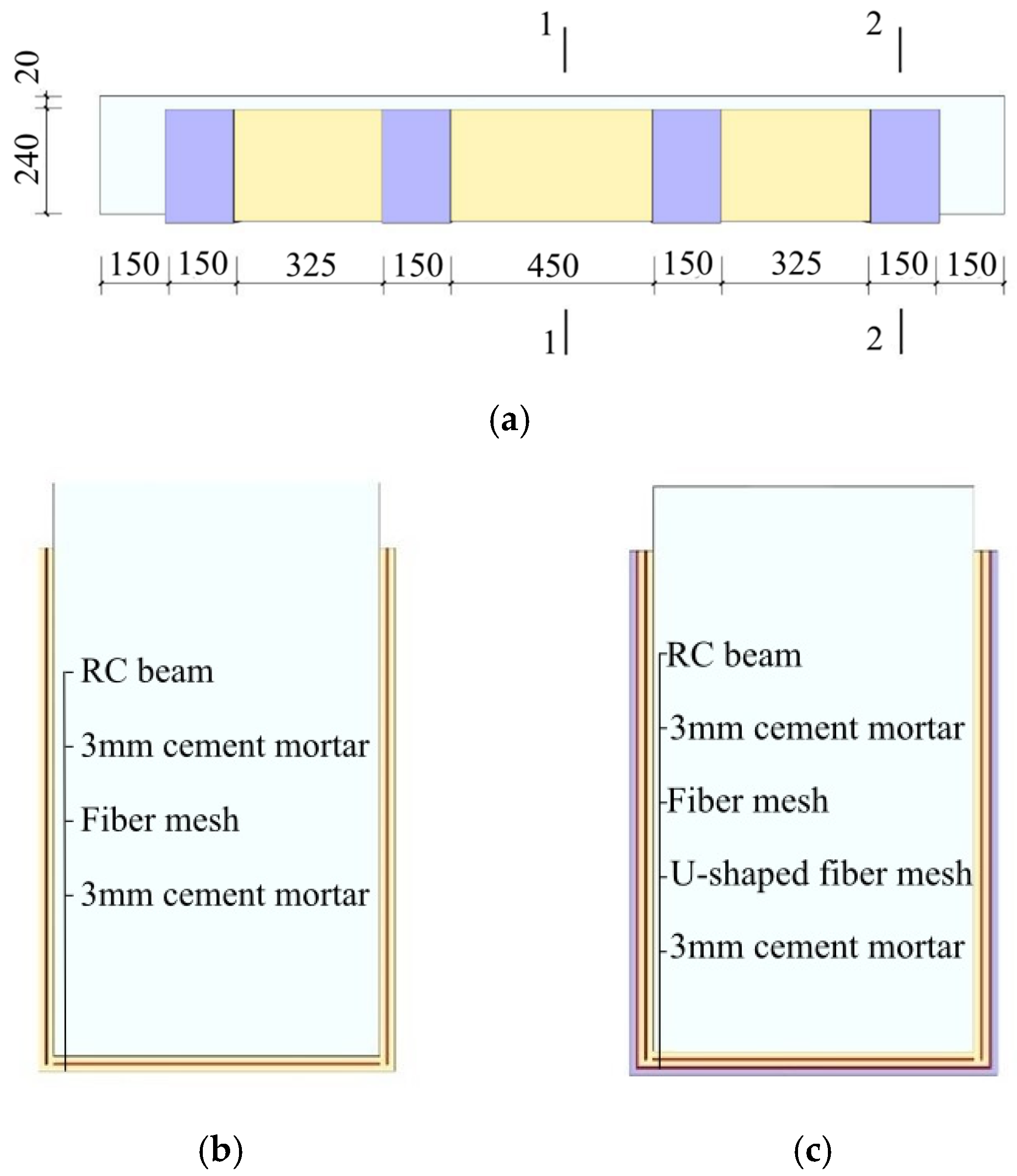
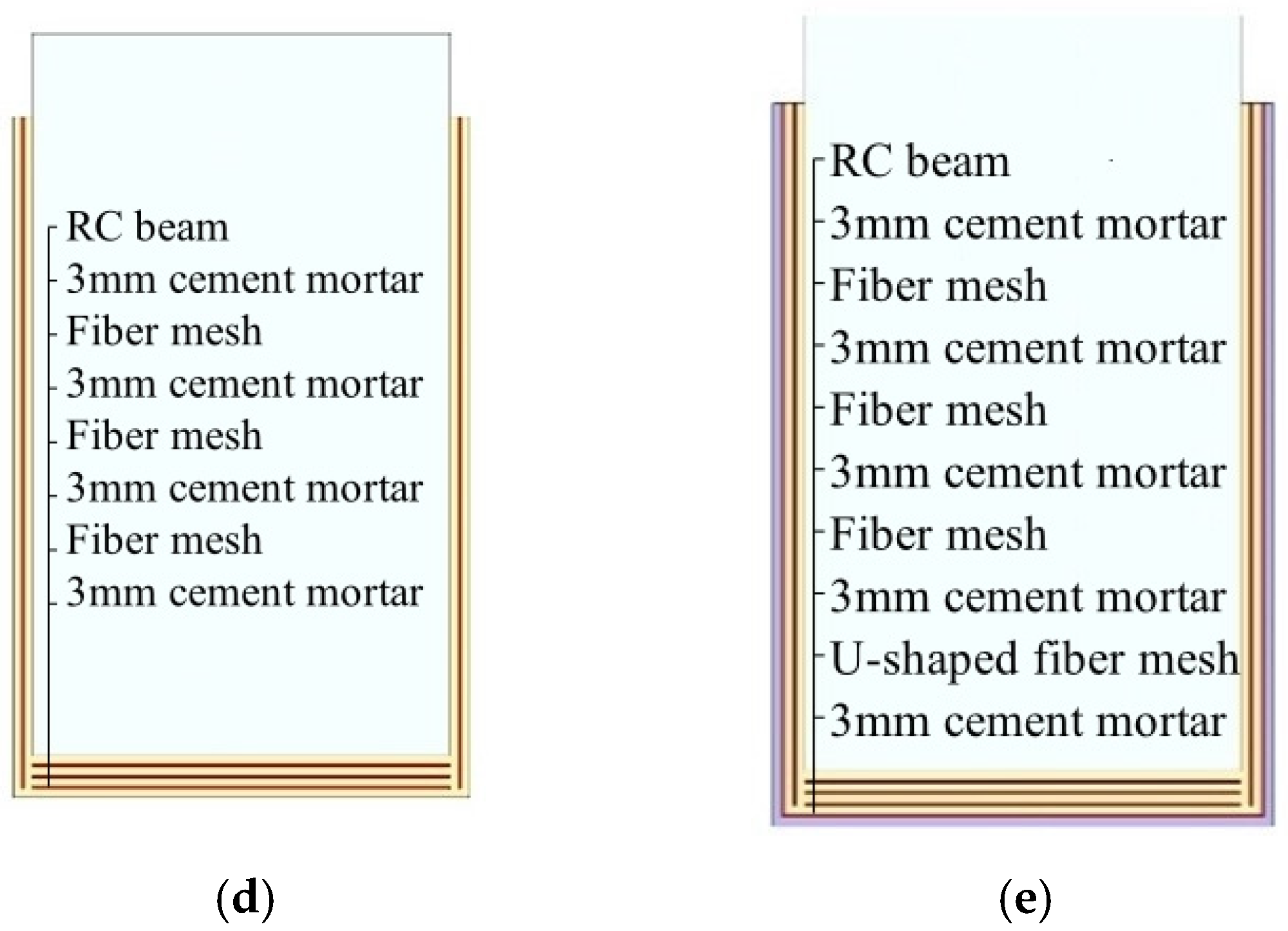



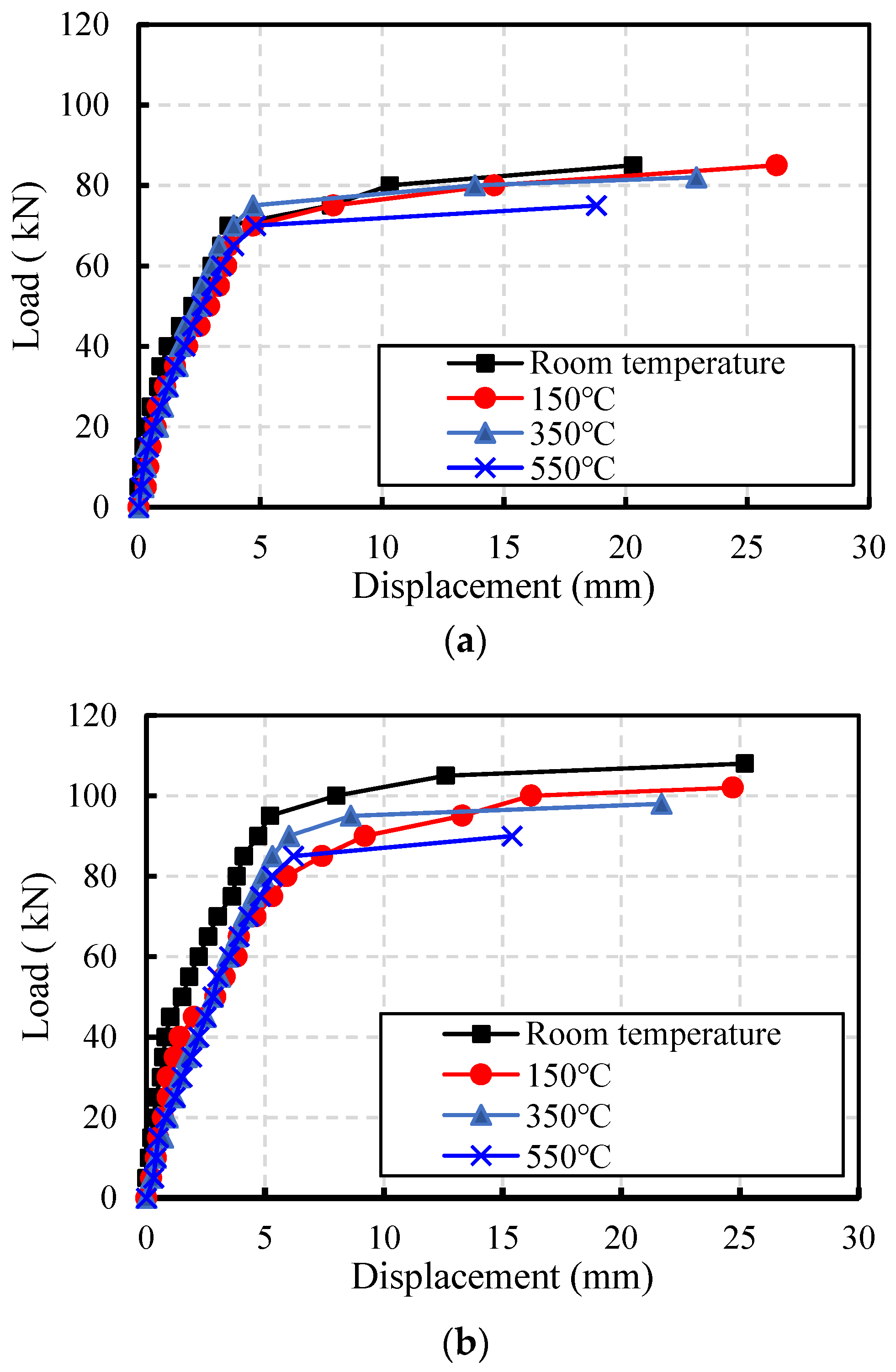

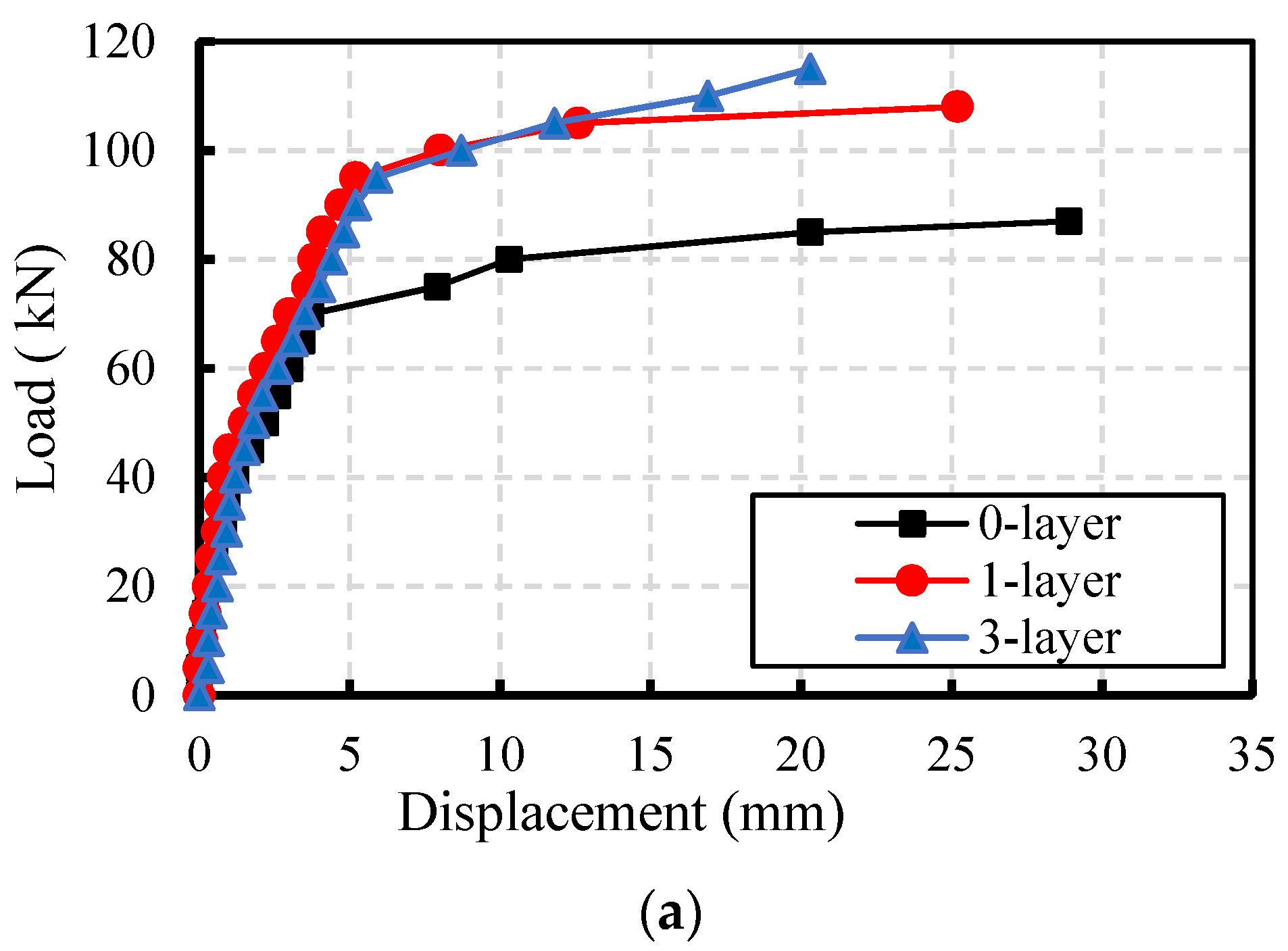
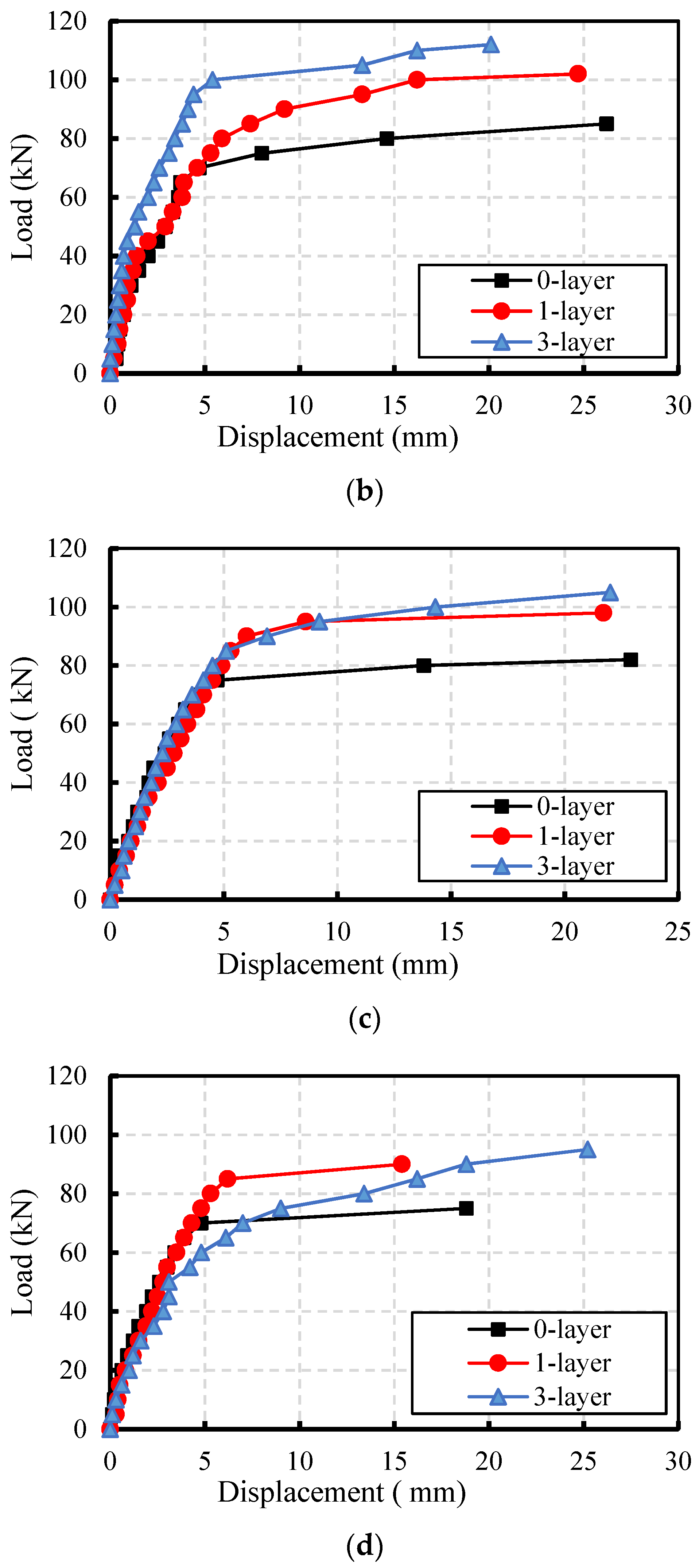
| Components | Water | Cement | Sand | Aggregate | Fly Ash | Mineral Powder | Admixture |
|---|---|---|---|---|---|---|---|
| Dosage (kg/m3) | 175 | 228 | 784 | 1083 | 70 | 60 | 8.6 |
| Rebar Diameter (mm) | Temperature (°C) | Yield Strength (MPa) | Ultimate Strength (MPa) |
|---|---|---|---|
| 8 | Room temperature | 446.30 | 620.52 |
| 150 | 428.54 | 608.08 | |
| 350 | 415.21 | 595.74 | |
| 550 | 391.92 | 569.86 | |
| 12 | Room temperature | 433.47 | 599.35 |
| 150 | 427.81 | 586.88 | |
| 350 | 420.56 | 583.42 | |
| 550 | 406.94 | 575.46 |
| Elastic Modulus (kN/mm2) | Weight of Fibers in the Direction of Force (g/m2) | Ultimate Failure Load of Each Bundle of Fibers (N) |
|---|---|---|
| 230 | 80 (both directions) | ≥3200 |
| Component Number | Heating Temperature (°C) | Layers of CFM |
|---|---|---|
| T20-0 | Room temperature | 0 |
| T20-1 | Room temperature | 1 |
| T20-3 | Room temperature | 3 |
| T150-0 | 150 | 0 |
| T150-1 | 150 | 1 |
| T150-3 | 150 | 3 |
| T350-0 | 350 | 0 |
| T350-1 | 350 | 1 |
| T350-3 | 350 | 3 |
| T550-0 | 550 | 0 |
| T550-1 | 550 | 1 |
| T550-3 | 550 | 3 |
| Beam Number | Cracking Load (kN) | Ultimate Load (kN) | Ultimate Displacement (mm) |
|---|---|---|---|
| T20-0 | 18.2 | 87 | 28.9 |
| T20-1 | 24 | 108 | 25.2 |
| T20-3 | 26 | 115 | 20.3 |
| T150-0 | 16.4 | 85 | 26.2 |
| T150-1 | 22 | 102 | 24.7 |
| T150-3 | 25 | 112 | 20.1 |
| T350-0 | 16.3 | 82 | 22.9 |
| T350-1 | 21.4 | 98 | 21.7 |
| T350-3 | 24 | 105 | 22 |
| T550-0 | 15.5 | 75 | 18.8 |
| T550-1 | 16.8 | 90 | 15.4 |
| T550-3 | 18.6 | 95 | 25.2 |
Disclaimer/Publisher’s Note: The statements, opinions and data contained in all publications are solely those of the individual author(s) and contributor(s) and not of MDPI and/or the editor(s). MDPI and/or the editor(s) disclaim responsibility for any injury to people or property resulting from any ideas, methods, instructions or products referred to in the content. |
© 2024 by the authors. Licensee MDPI, Basel, Switzerland. This article is an open access article distributed under the terms and conditions of the Creative Commons Attribution (CC BY) license (https://creativecommons.org/licenses/by/4.0/).
Share and Cite
Cheng, J.; Wang, H.; Xu, Z.; Yuan, G.; Li, Q. Mechanical Properties of Fire-Damaged RC Beams Reinforced with Carbon Fiber Mesh. Buildings 2024, 14, 1166. https://doi.org/10.3390/buildings14041166
Cheng J, Wang H, Xu Z, Yuan G, Li Q. Mechanical Properties of Fire-Damaged RC Beams Reinforced with Carbon Fiber Mesh. Buildings. 2024; 14(4):1166. https://doi.org/10.3390/buildings14041166
Chicago/Turabian StyleCheng, Jinsheng, Hao Wang, Zhisong Xu, Guanglin Yuan, and Qingtao Li. 2024. "Mechanical Properties of Fire-Damaged RC Beams Reinforced with Carbon Fiber Mesh" Buildings 14, no. 4: 1166. https://doi.org/10.3390/buildings14041166





